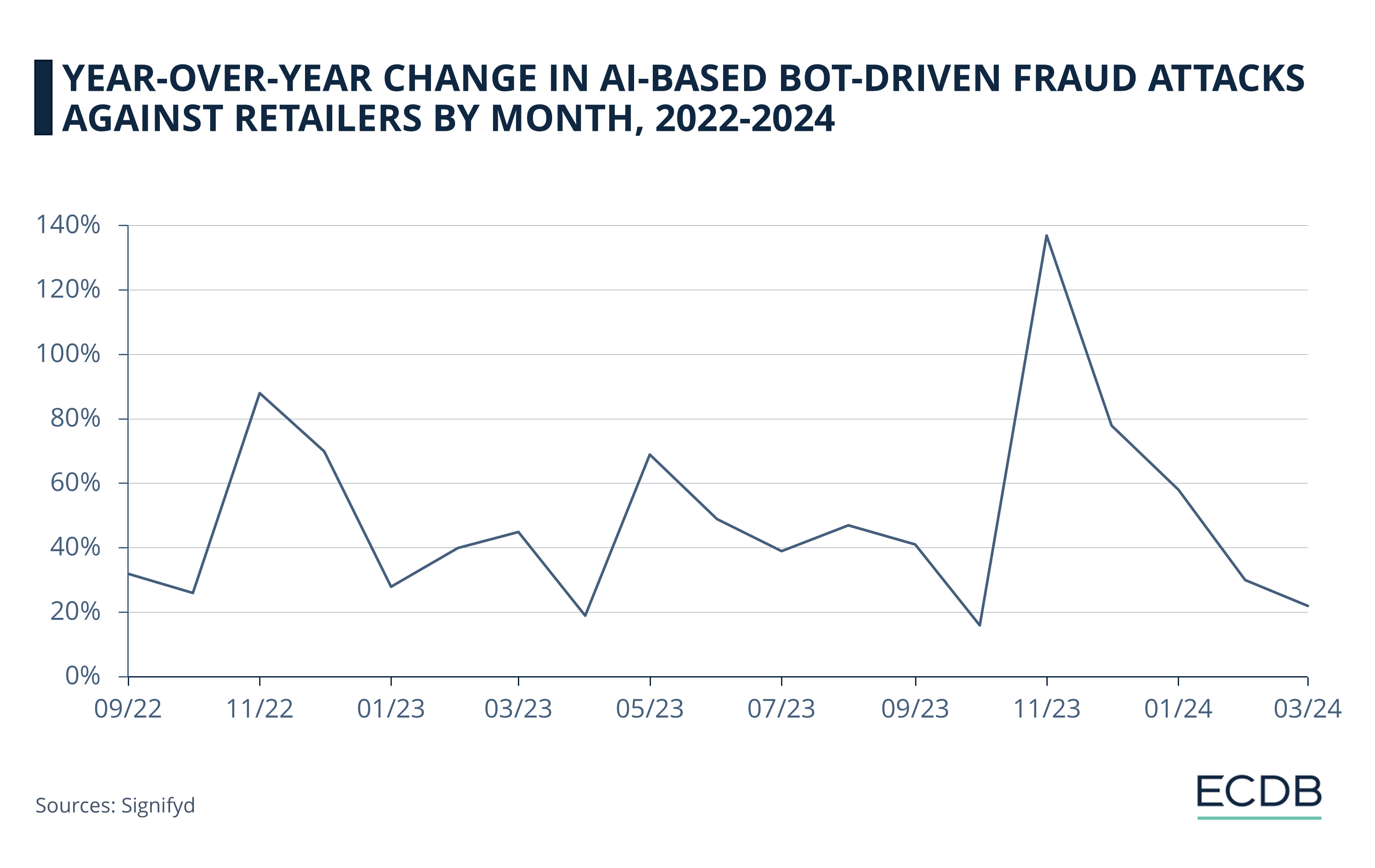eCommerce: Fraud
Artificial Intelligence and Fraud in eCommerce
Like any great invention, artificial intelligence is also being used in bad ways. Utilizing this technology, fraudsters find new ways to scam online shoppers.
Article by Cihan Uzunoglu | September 18, 2024
Artificial Intelligence and Fraud in eCommerce: Key Insights
Advanced Fraud Methods: Fraud rings are now using sophisticated techniques like fake accounts, custom software, and AI-generated deep fakes to manipulate customer service and carry out large-scale fraud.
Holiday Fraud Surges: AI-driven bot fraud spikes during high-traffic shopping seasons, particularly in November, where 2023 saw a 137% increase as fraudsters took advantage of events like Black Friday and Cyber Monday.
Evolving Fraud Prevention: To combat these rising threats, businesses are adopting machine learning to detect and block AI-powered fraud in real time, allowing them to better manage risks and safeguard customer trust.
Artificial intelligence (AI) is transforming both fraud and the fight against it, with the competition increasingly seen as AI versus AI. Fraudsters have adopted advanced AI techniques to carry out bot attacks, phishing scams, and credential stuffing, enabling them to automate massive fraud operations.
These AI-powered bot attacks have surged by 140% during peak shopping seasons, according to Signifyd data.
Heightened Fraudulent Activity in November
Fraud rings, organized groups of criminals working together to commit large-scale fraud, are becoming increasingly sophisticated. Popular methods include creating fake accounts, writing custom software, and creating realistic phishing emails that are harder to detect. Deep fakes and AI-generated voices now mimic real customers, fooling customer service representatives into approving fraudulent transactions.
Data shows the year-over-year change in AI-based bot-driven fraud attacks against retailers by month from 2022 to 2024:

While most months in the data hover around 20-40% year-over-year change, high fraudulent activity is seen in November.
The spikes in fraudulent activity, particularly in November, align with the peak shopping period driven by events like Black Friday and Cyber Monday.
Retailers must remain vigilant during these peak periods, as the surge in attacks poses significant risks to both their revenue and reputation.
Machine Learning in Fighting Against
AI-Powered Fraud
On the other side, businesses are leveraging machine learning to protect themselves from these AI-driven fraud attacks. Machine learning is vital for detecting and preventing fraud at scale, helping merchants manage risks and maintain customer trust.
More Insights? We keep our rankings up to date with the latest data, offering you valuable information to improve your business. Want to know which stores and companies are leading the way in eCommerce? Which categories are achieving the highest sales? Check out our rankings for companies, stores, and marketplaces. Stay one step ahead with ECDB.
According to Xavi Sheikrojan, a fraud expert, machine learning is the first line of defense, capable of identifying and stopping fraud in real time.

Artificial Intelligence and Fraud
in eCommerce: Final Thoughts
As AI continues to evolve, its role in conducting and combating fraud in eCommerce will only grow stronger. Over the next years, AI will likely become essential in identifying and preventing fraud at every stage, from returns management to payment processing. Fraud detection systems will become more sophisticated, utilizing real-time data and machine learning to stay ahead of evolving threats.
As fraudsters refine their tactics, businesses will increasingly rely on AI to protect their platforms, reducing risks and improving customer trust in a rapidly advancing digital sector.
Sources: Signifyd, ECDB

Click here for
more relevant insights from
our partner Mastercard.
Related insights
Deep Dive
Next Generation eCommerce: Key Trends Shaping the New Age of Online Retail
Next Generation eCommerce: Key Trends Shaping the New Age of Online Retail
Deep Dive
Google's AI Project Jarvis Could Change Online Shopping
Google's AI Project Jarvis Could Change Online Shopping
Deep Dive
FTC’s New Ban in Effect & How to Spot Fake Reviews in Online Shopping
FTC’s New Ban in Effect & How to Spot Fake Reviews in Online Shopping
Deep Dive
How to Avoid Online Shopping Scams Ahead of the Holiday Season
How to Avoid Online Shopping Scams Ahead of the Holiday Season
Deep Dive
Artificial Intelligence in Italy eCommerce: Consumer Behavior & Preferences
Artificial Intelligence in Italy eCommerce: Consumer Behavior & Preferences
Back to main topics